Visual discrimination skills Normal Alphabet Worksheets for Ages 4-5
5 filtered results
-
From - To
Enhance your child's visual discrimination skills with our engaging Normal Alphabet Worksheets designed for ages 4-5. These worksheets encourage young learners to differentiate between various letters and shapes while fostering essential early literacy skills. Each activity is thoughtfully crafted to be fun and interactive, ensuring children remain motivated as they practice identifying letters, spotting differences, and recognizing subtle variations. Perfect for parents and educators, these resources provide an excellent foundation for developing strong reading and writing abilities. Discover the joy of learning through play with our vibrant and stimulating worksheets that will captivate your child's imagination while laying the groundwork for future success!


Letter L Coloring Sheet


Find Uppercase Letters A, B, and C Worksheet


Identifying Uppercase Letters Worksheet


Find lowercase letters a b c Worksheet


Find Lowercase Letters v w x Worksheet
Parents and teachers should prioritize visual discrimination skills in children aged 4-5 because these skills are foundational for successful literacy development. Visual discrimination refers to the ability to notice and identify differences and similarities in shapes, colors, and letters. For young learners, strong visual discrimination helps them to accurately recognize letters of the alphabet, which is essential for reading and writing.
As children begin their education, they encounter various letters and numbers that can easily be confused if visual discrimination is not developed. For example, children may struggle to differentiate between letters such as 'b' and 'd' or 'p' and 'q'. Improving these skills boosts their confidence in reading and reduces frustration.
Additionally, visual discrimination activities, such as sorting and matching games, can enhance cognitive processing, attention to detail, and overall academic success. These skills not only support literacy but also facilitate future learning in math and other subjects that require observational skills.
Encouraging young children to engage in visual discrimination activities fosters a sense of curiosity and exploration. Therefore, by investing time in these essential skills, parents and teachers equip children with the tools they need for lifelong learning and effective communication.
 Assign to My Students
Assign to My Students















